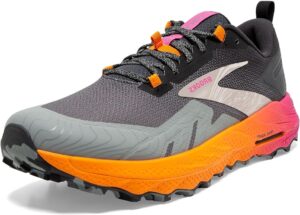
Choosing the Best Hiking and Trail Running Shoes
Whether you’re scaling rocky ridges or navigating a muddy forest path, selecting the right hiking or trail running shoes can dramatically affect your experience. With numerous brands on the market, it can be overwhelming to sift through the options. Today, let’s delve into some of the most popular choices: Salomon, Brooks, Nike, Saucony, New Balance, and ASICS. We’ll explore their strengths, weaknesses, features, and specific models that stand out.
Salomon: The Trail Conqueror
Strengths: Salomon is renowned for its robust construction and exceptional traction, making its shoes ideal for challenging terrains and slippery conditions. Their Quicklace system ensures a secure and adjustable fit.
Weaknesses: Some models may feel too narrow for wider feet and often, they lack the plush cushioning that some runners prefer for longer distances.
Key Models:
- Salomon Speedcross 5: Known for its aggressive grip, the Speedcross is a favorite among trail runners tackling soft, technical, or muddy trails.
- Salomon Alpha Cross 5: A great option for runners and hikers, offering GORE-TEX waterproof protection and a supportive, cushioned midsole ideal for longer treks.
Brooks: Comfort on the Trail
Strengths: Brooks excels in comfort, thanks to its BioMoGo DNA cushioning technology, which adapts to your stride. The brand is known for its durable, high-quality shoes that offer a balance of flexibility and support.
Weaknesses: Some Brooks models might not provide enough grip for extremely rugged terrains compared to other specialized trail brands.
Key Models:
- Brooks Cascadia 17: Offers a pivot system for stability on uneven ground, and substantial cushioning ideal for long-distance runners.
- Brooks Ghost 14 GTX: A versatile shoe with a waterproof GORE-TEX membrane, suitable for both trail runners and urban joggers who encounter wet conditions.
Nike: High-Tech Performance
Strengths: Nike’s trail shoes are lightweight and feature cutting-edge technology like Nike React foam, providing a responsive ride. They are designed for speed and agility on the trails.
Weaknesses: Durability can be an issue with some models, as the lightweight materials may not withstand harsh, technical terrains over time.
Key Models:
- Nike Air Zoom Terra Kiger 7: Features a ventilated mesh upper and a sticky rubber outsole for optimal traction on rocky surfaces.
- Nike Pegasus Trail 4: A hybrid model good for roads and trails, providing ample cushioning and a more durable outsole.
Saucony: Reliable and Versatile
Strengths: Saucony shoes often feature a comfortable fit with ample room in the toe box, and their POWERTRAC outsole technology offers excellent traction on a variety of surfaces.
Weaknesses: While versatile, Saucony’s trail shoes might lack the specialized features needed for more extreme conditions.
Key Models:
- Saucony Peregrine 11: A solid all-rounder with aggressive lugs for grip and a responsive midsole for cushioning.
- Saucony Xodus 11: Built for durability and comfort, it’s ideal for rough trails and ultra-distances.
New Balance: Innovation Meets Tradition
Strengths: New Balance trail shoes are known for their perfect fit, thanks to offerings in multiple widths. Their Fresh Foam technology ensures a smooth and comfortable ride.
Weaknesses: Some models are on the heavier side, which could slow you down on more technical sections.
Key Models:
- New Balance Fresh Foam Hierro v6: Provides a plush ride with a Vibram outsole for superior grip.
- New Balance DynaSoft Nitrel V5: Offers a protective toe cap and a REVlite midsole, making it suitable for both competitive trail runners and casual hikers.
ASICS: Cushioned and Protective
Strengths: ASICS excels in gel cushioning, which reduces impact and increases comfort. They also focus heavily on foot protection and stability.
Weaknesses: These shoes can sometimes feel bulkier and less flexible, which might not appeal to those who prefer a more minimalist shoe.
Key Models:
- ASICS GEL-Venture 9: An affordable option with high-abrasion rubber for durability and GEL technology for shock absorption.
- ASICS GEL-Excite Trail 2: Features a rock protection plate and an ASICSGRIP outsole for stability on varied terrains.
Conclusion
Choosing the right hiking and trail running shoes depends largely on the type of terrain you plan to tackle, your personal comfort preferences, and specific foot needs. Each of these brands offers unique benefits, from Salomon’s unmatched grip to Brooks’ exceptional comfort and ASICS’ superior cushioning. It’s crucial to try them on, consider where you’ll be using them most, and ensure they’re well broken in before hitting the trail for your next adventure.
My wife and I always carry two pairs of shoes with us for several reasons. Firstly, if we’re out hiking and conditions become muddy and wet, we can switch shoes and not have to endure soggy footwear for the rest of the day. This also allows us to properly clean and dry our hiking shoes. Secondly, we enjoy running and working out at the gym, so having a pair of shoes specifically for that helps a lot. Lastly, after a long day of hiking, slipping on a fresh pair of shoes to go to dinner not only feels great but also reinvigorates our feet.
We both wear Salomons as our primary hiking shoes—I have the Alpha Cross 5s and my wife wears the Speed Cross 5s. For our running and gym workouts, she opts for the Brooks Ghosts, and I use the Brooks Hyperion Tempos. All of these shoes have held up incredibly well over countless miles. Remember, choosing shoes is a very personal decision, so it’s essential to try before you buy to ensure comfort and satisfaction.





